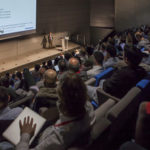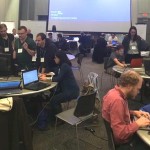Today the PASC17 Conference announced a track focused on Precision Medicine as Special Topic for Emerging Domains. “Precision medicine, also referred to as personalized medicine, is an emerging domain that is adding tremendous value to the study of life sciences and medical treatment. The requirements that it has for rapid – and secure – processing, analysis and management of vast quantities of data in a wide range of different medical environments make precision medicine ideally suited to high performance computing.”
First Look: BeeGFS File System at CSCS
In this video from the HPC Advisory Council Spain Conference, Hussein Harake provides an overview of the CSCS and then introduces the audience to the BeeGFS parallel file system. “BeeGFS (formerly FhGFS) is an up and coming parallel cluster file system for I/O intensive workloads. Developed with a strong focus on performance, BeeGFS was designed for very easy installation and management.”
Powering Aircraft CFD with the Piz Daint Supercomputer
The Piz Daint supercomputer at the Swiss National Supercomputing Centre (CSCS) is again assisting researchers in competition for the prestigious Gordon Bell prize. “Researchers led by Peter Vincent from Imperial College London have made this year’s list of finalists for the Gordon Bell prize, with the backing of Piz Daint at the Swiss National Supercomputing Centre. The prize is awarded annually in November at SC, the world’s largest conference on supercomputing. It honors the success of scientists who are able to achieve very high efficiencies for their research codes running on the fastest supercomputer architectures currently available.”
Exascale Computing – What are the Goals and the Baseline?
Thomas Schulthess presented this talk at the MVAPICH User Group. “Implementation of exascale computing will be different in that application performance is supposed to play a central role in determining the system performance, rather than just considering floating point performance of the high-performance Linpack benchmark. This immediately raises the question as to what the yardstick will be, by which we measure progress towards exascale computing. I will discuss what type of performance improvements will be needed to reach kilometer-scale global climate and weather simulations. This challenge will probably require more than exascale performance.”
Creating Balance in HPC on the Piz Daint Supercomputer
The flagship supercomputer at the Swiss National Supercomputing Centre (CSCS), Piz Daint, named after a mountain in the Alps, currently delivers 7.8 petaflops of compute performance, or 7.8 quadrillion mathematical calculations per second. A recently announced upgrade will double its peak performance, thanks to a refresh using the latest Intel Xeon CPUs and 4,500 Nvidia Tesla P100 GPUs.
Video: PASC16 Poster on Peptide Simulation
In this video from PASC16, Annick V. Renevey from ETH Zurich describes her award-winning poster on peptide simulations at CSCS.
Supercomputing and the Search for Dark Matter
Over at CSCS, Simone Ulmer writes that Particle physicists using the Piz Daint supercomputer have determined what is known as the scalar quark content of the proton. The research will help efforts to detect and research dark matter.
PASC16 Wraps in Lausanne
Scientists from a wide range of disciplines gathered at the SwissTech Convention Center in Lausanne from 8 to 10 June 2016 for this year’s PASC Conference. The use of high-performance computing in their research was the common bond that brought them together. From 8 to 10 June, the SwissTech Convention Center played host to around 360 scientists from Europe, the USA, Canada, Japan, Russia, Saudi Arabia, South Africa and Singapore, offering plenty of space and scope for them to engage in an interdisciplinary discourse on current issues relating to scientific computing.
Supercomputing Hidden Lava Lakes
The Piz Daint supercomputer spotted a large reservoir of magma right below the tiny South Korean island of Ulleung. No harm to humans is expected, but the origin of the magma pool remains unclear.
Video: Accelerating Code at the GPU Hackathon in Delaware
In this video from the GPU Hackathon at the University of Delaware, attendees tune their code to accelerate their application performance. The 5-day intensive GPU programming Hackathon was held in collaboration with Oak Ridge National Lab (ORNL). “Thanks to a partnership with NASA Langley Research Center, Oak Ridge National Laboratory, National Cancer Institute, National Institutes of Health (NIH), Brookhaven National Laboratory and the UD College of Engineering, UD students had access to the world’s second largest supercomputer — the Titan — to help solve real-world problems.”











